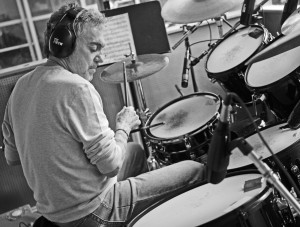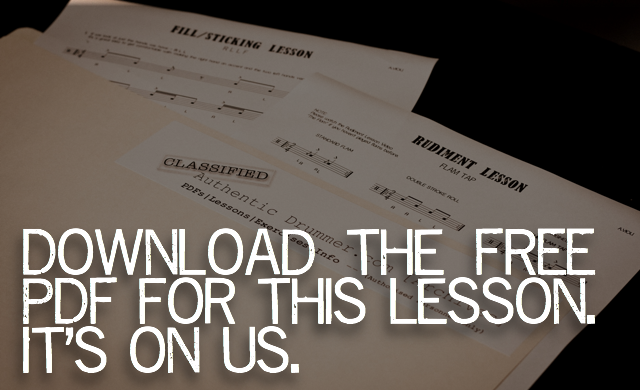Here’s an essential lesson. Using Paradiddles as grooves.
I use this type of groove every single time I play the drums at some stage or another. It’s the perfect way to take a basic groove and give it a lift. In essence, we are playing a single paradiddle (RLRR LRLL) between the hi-hats and the snare drum and adding bass drums throughout as needed. Simple in theory yes?
 In reality, this groove can sound very busy an uncharacteristically out of context if not treated properly. If you’re playing a basic drum beat with the snare drum on 2 and 4, you wouldn’t want to lose the backbeat when you played your fancy paradiddle groove. It would detract from the music and yield some looks from the band. As such the way to approach this groove is to play the paradiddle itself softly and emphasise beats 2 and 4 with an accent on the snare drum. This way, the essence of the groove is still there and it makes the paradiddle groove way more useful in a variety of situations.
In reality, this groove can sound very busy an uncharacteristically out of context if not treated properly. If you’re playing a basic drum beat with the snare drum on 2 and 4, you wouldn’t want to lose the backbeat when you played your fancy paradiddle groove. It would detract from the music and yield some looks from the band. As such the way to approach this groove is to play the paradiddle itself softly and emphasise beats 2 and 4 with an accent on the snare drum. This way, the essence of the groove is still there and it makes the paradiddle groove way more useful in a variety of situations.
So in a bar of 4/4 time you would play this:
R L R R L R L L R L R R L R L L
If you wanted to, you could put an accent on the beats 1 and 3 too on the hi-hat. You’d end up with this:
R L R R L R L L R L R R L R L L
The PDF available for download below has some exercises using the paradiddle as shown in the hands and a variety of bass drum patterns to go underneath. You’ll discover some easy beats and ones that will challenge you. For the grooves to feel good, make sure you keep the non-accented notes soft – even when you play your bass drum! This will mean playing soft on the left hand while you kick with your right foot – rather tricky at first.
It’s entirely up to you if you want to put an accent on the hi-hat when you play the bass drum under it. Bear in mind though, if you’re using these grooves as a replacement for a basic groove, other accents besides the backbeat could take away from the fundamental feel. Be careful of that. If it’s fill? Go for it. Do whatever!
Steve Gadd is really good at Paradiddle grooves and this concept in general – he’s taken things a step further but definitely worth checking out as he’s a master at ghost notes. Gadd often uses a hybrid groove RLLR LRLL – a mixture of the inward and single paradiddles. Lot’s of possibilities available.
Enjoy the vid.


Hi Adrian, I felt I had to let you know how superb I think your lessons are. They are so clear, uncluttered by bs very informative and for my money I think the best on the web. A little more on jazz drumming would be nice and how about a transcription of the drum .intro to your site. What the heck do I know anyhow , I’ve only been playing for 65 years and still learning new stuff courtesy of your brilliant site.Keep up the good work and I look forward eagerly to your next lesson, Many thanks.
Mike, I can’t thank you enough for your kind words. It never really matters if only a select few drummers watch my videos because if awesome people like you are getting something out of them – that’s all I need. I really appreciate your comments. I’ll take on board your suggestions. Going to be shooting some more stuff soon – some more jazz then! As for the intro to the site?? Well, that was a little mix/match of me taking a solo. I’ll see what I can do! Actually, I’ve never taken a video of me doing an open solo. Maybe that’s the next thing. Thanks again for your comments. Keep in touch! Cheers.
Wnt 2 learn
This is so useful. I’ve been playing paradidles between hi-hats and snare for years and there is always something new to it. These are really good and systematic exercises. Cant wait for part 2. I’m going to practice this. Will be a good workout. 🙂 Keep the lessons coming!
Glad you’re getting something out of these lessons Milan!